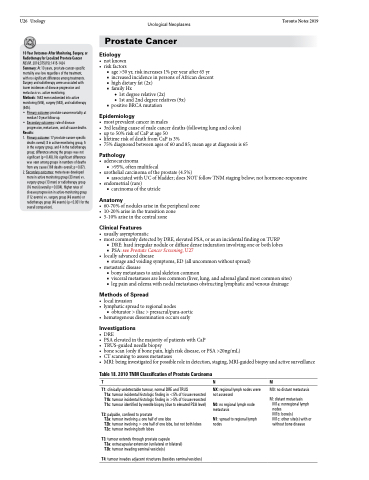Page 1344 - TNFlipTest
P. 1344
U26 Urology
Urological Neoplasms
Toronto Notes 2019
10 Year Outcomes After Monitoring, Surgery, or Radiotherapy for Localized Prostate Cancer NEJM. 2016;375(15):1415-1424
Summary: At 10 years, prostate-cancer-specific mortality was low regardless of the treatment, withnosignificantdifferenceamongtreatments. Surgeryandradiotherapywereassociatedwith lower incidences of disease progression and metastasis vs. active monitoring.
Methods: 1643 men randomized into active monitoring (545), surgery (553), and radiotherapy (545).
• Primaryoutcome:prostate-cancermortalityat
median 10 year follow-up.
• Secondary outcomes: rate of disease
progression,metastases,andall-causedeaths. Results:
1. Primaryoutcome:17prostate-cancer-specific deaths overall; 8 in active-monitoring group, 5 in the surgery group, and 4 in the radiotherapy group; difference among the groups was not significant (p=0.48). No significant difference was seen among groups in numbers of deaths fromanycause(169deathsoverall;p=0.87).
2.Secondaryoutcomes:metastasesdeveloped more in active monitoring group (33 men) vs. surgery group (13 men) or radiotherapy group (16 men) (overall p=0.004). Higher rates of disease progression in active-monitoring group (112 events) vs. surgery group (46 events) or radiotherapy group (46 events) (p<0.001 for the overall comparison).
Prostate Cancer
Etiology
• notknown • riskfactors
■ age >50 yr, risk increases 1% per year after 65 yr
■ increasedincidenceinpersonsofAfricandescent ■ highdietaryfat(2x)
■ family Hx
◆ 1st degree relative (2x)
◆ 1st and 2nd degree relatives (9x) ■ positiveBRCAmutation
Epidemiology
• most prevalent cancer in males
• 3rdleadingcauseofmalecancerdeaths(followinglungandcolon)
• upto50%riskofCaPatage50
• lifetimeriskofdeathfromCaPis3%
• 75%diagnosedbetweenagesof60and85;meanageatdiagnosisis65
Pathology
• adenocarcinoma
■ >95%,oftenmultifocal
• urothelialcarcinomaoftheprostate(4.5%)
■ associated with UC of bladder; does NOT follow TNM staging below; not hormone-responsive
• endometrial(rare)
■ carcinoma of the utricle
Anatomy
• 60-70%ofnodulesariseintheperipheralzone • 10-20%ariseinthetransitionzone
• 5-10%ariseinthecentralzone
Clinical Features
• usuallyasymptomatic
• mostcommonlydetectedbyDRE,elevatedPSA,orasanincidentalfindingonTURP
■ DRE: hard irregular nodule or diffuse dense induration involving one or both lobes
■ PSA: see Prostate Cancer Screening, U27 • locallyadvanceddisease
■ storage and voiding symptoms, ED (all uncommon without spread) • metastaticdisease
■ bony metastases to axial skeleton common
■ visceral metastases are less common (liver, lung, and adrenal gland most common sites) ■ leg pain and edema with nodal metastases obstructing lymphatic and venous drainage
Methods of Spread
• localinvasion
• lymphaticspreadtoregionalnodes
■ obturator > iliac > presacral/para-aortic • hematogenousdisseminationoccursearly
Investigations
• DRE
• PSAelevatedinthemajorityofpatientswithCaP
• TRUS-guidedneedlebiopsy
• bonescan(onlyifbonepain,highriskdisease,orPSA>20ng/mL)
• CTscanningtoassessmetastases
• MRI:beinginvestigatedforpossibleroleindetection,staging,MRI-guidedbiopsyandactivesurveillance
Table 18. 2010 TNM Classification of Prostate Carcinoma
TNM
T1: clinically undetectable tumour, normal DRE and TRUS
T1a: tumour incidental histologic finding in <5% of tissue resected T1b: tumour incidental histologic finding in >5% of tissue resected T1c: tumour identified by needle biopsy (due to elevated PSA level)
T2: palpable, confined to prostate
T2a: tumour involving ≤ one half of one lobe
T2b: tumour involving > one half of one lobe, but not both lobes T2c: tumour involving both lobes
T3: tumour extends through prostate capsule
T3a: extracapsular extension (unilateral or bilateral) T3b: tumour invading seminal vesicle(s)
T4: tumour invades adjacent structures (besides seminal vesicles)
NX: regional lymph nodes were not assessed
N0: no regional lymph node metastasis
N1: spread to regional lymph nodes
M0: no distant metastasis
M: distant metastasis M1a: nonregional lymph nodes
M1b: bone(s)
M1c: other site(s) with or without bone disease


